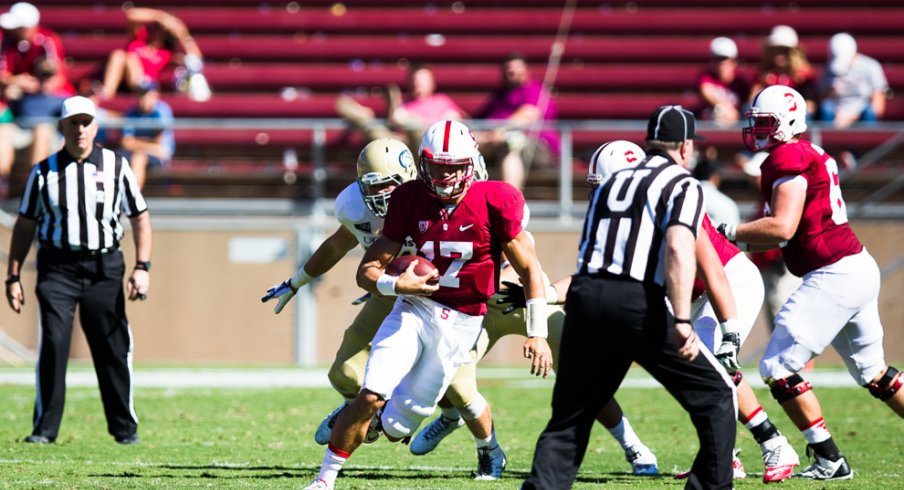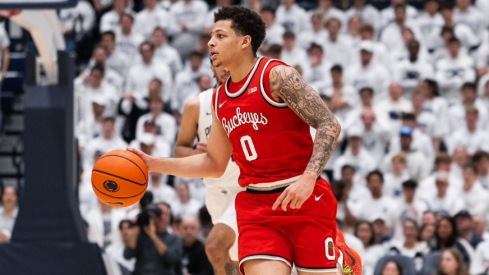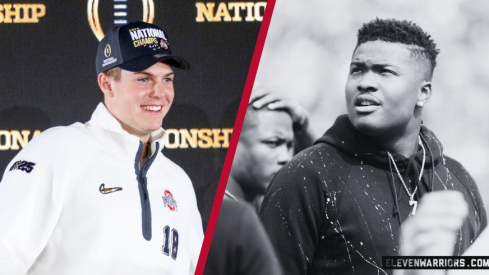"If you're not getting better, you're getting worse."
Defending a national championship is hard work, and Ohio State's toughest battle in 2015 will be against complacency. That turn of phrase exemplifies what the Buckeyes need to do to repeat as champions – find ways to keep improving.
One of those forms of improvement is for coaches to visit other schools, which they do to pick up knowledge and find tweaks to use with their own teams. It's a practice Urban Meyer and his staff use frequently, even when they're not coaching.
In 2011, while Meyer was working for ESPN, he visited Oregon to learn more about Chip Kelly's up-tempo offensive attack and found out how quick and energetic the Ducks' practices were. Four years later, facing the Ducks in the national championship game, Ohio State was prepared for their speed. The Buckeyes put in far more work than Meyer's visit to beat Oregon, but it gave the man in charge valuable in-person experience with an elite offense.
This offseason, when Ohio State's coaches aren't recruiting or staffing their own coaching camps, they will likely head to other schools to pick up tips and strategies to use for the offense in Columbus. I have two suggestions for places to go, one for the passing game and one for the rushing game.
Stanford
When you're looking for ways to improve your program, you want to find extremes and outliers. In a time when most schools are trying to speed up and spread out, Stanford's offense tends towards bulkiness and cracking skulls.
Starting with Jim Harbaugh and continuing under David Shaw, Stanford bucked decades of mediocrity by building an offensive identity on beefiness. In an article last year, USA Today's Nicole Auerbach summarized Stanford's usage of the heavies:
But the beauty of Stanford's system is that, by using heavy sets, rotating up to 11 linemen in and out and using others (like new starting right tackle Kyle Murphy, who played a lot of tight end in the Jumbo set last season) in very specific roles, younger linemen can get a great deal of in-game experience even if they're not starting. It's certainly a selling point.
Playing time isn't Stanford's only selling point: it has sent nine offensive linemen and tight ends to the NFL since 2010. In the same time span, Ohio State sent five.
Stanford did take a step back in 2014, finishing 8-5. It was still a good team (18th in Football Outsiders' 2014 F/+ ratings), but its offense was dull and punchless.
If Buckeye coaches were to visit Stanford this summer, they would want to pick up tips on offensive lineman development and jumbo sets, and try not to emulate the offensive playcalling.
Western Kentucky
Going to mid-major schools to pick up tips is, in many respects, hipster-ish. Finding something rad that most people don't appreciate, spending time in the culture to better appreciate it, bragging about a really cool, authentic coaching camp that hasn't been co-opted, and seeing that thing become so widely appreciated that it goes from niche to the boring norm? It's the whole life cycle of a trend.
In any case, Western Kentucky would be an interesting school to monitor. In 2013, under head coach Bobby Petrino, WKU's Brandon Doughty threw for 14 touchdowns and 14 interceptions. In 2014, under new head coach Jeff Brohm, Doughty threw for 2,000 more yards 49 touchdowns and 10 interceptions. Its offense benefited from a blinding pace, but clearly something changed.
What makes Western Kentucky an interesting school is its ball distribution. Six receivers had 30 or more catches in 2014, compared to three for the Buckeyes. Eight Hilltoppers had 20 or more receptions, compared to six for the Buckeyes. With Ohio State losing Devin Smith to the NFL, it may need to distribute the ball more evenly; WKU is a blueprint for how to do so.
Western Kentucky isn't a case of a school totally abandoning the run, either. Its top running back Leon Allen, not an overwhelming pro prospect, ran for 1,542 yards at 5.7 yards per carry. Ohio State's running stable is much deeper; what could it do?
With Doughty, Allen and the three top receivers returning for their senior seasons, the Hilltoppers could have an incredible 2015. Before WKU becomes too mainstream, Ohio State's coaches should consider taking a trip to Bowling Green, Ky. to see what Brohm and offensive coordinator Tyson Helton have cooking.


